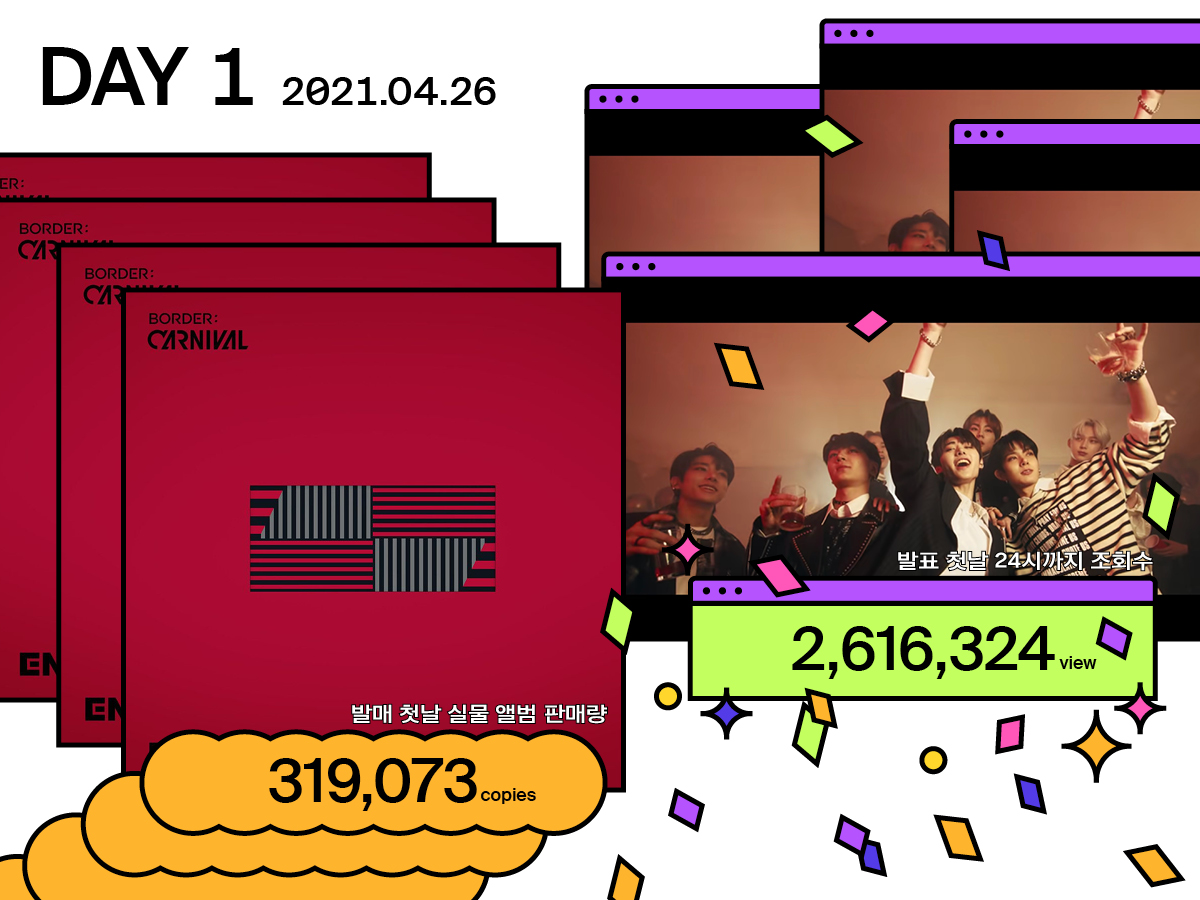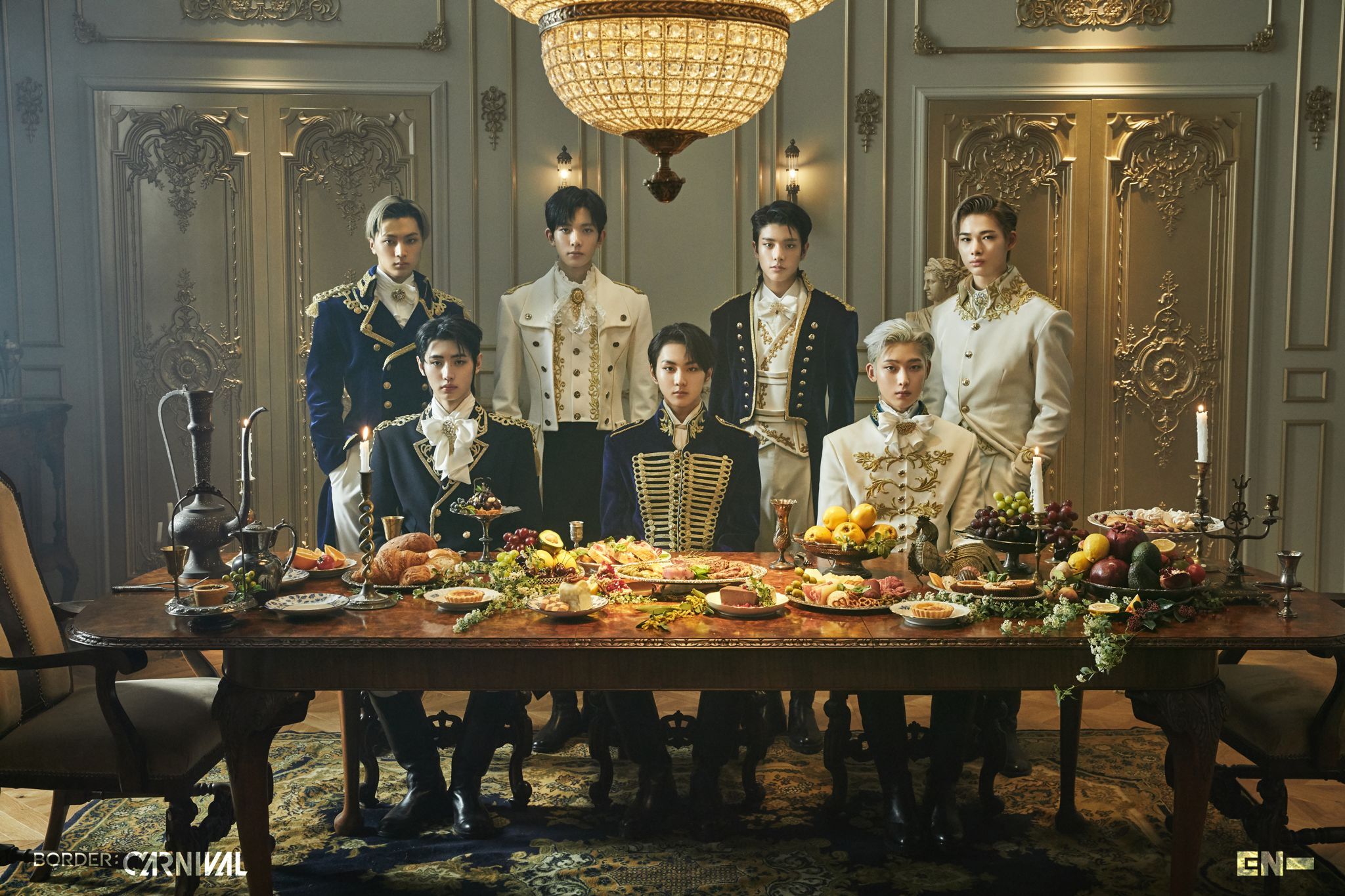
The festival that flipped everything, Act One
Rieun Kim: The music video for the lead single “Given-Taken” from ENHYPEN’s debut album BORDER : DAY ONE told us of a strange, fanged life. The performance for “Drunk-Dazed,” the lead single from their follow-up album, BORDER : CARNIVAL, uses the death metaphors from the previous album as a symbol. The way the members first stagger out, and the way they emphasize their joints by bending their wrists and showing their palms, or stretching their arms and legs out straight in the choreography during the chorus, leads us to see them like zombies or vampires—beings somewhere on the threshold between life and death. But what’s really on display here is the electric, full-force performance of the ENHYPEN members. When HEESEUNG steps forward from dancing with NI-KI and SUNGHOON in the first verse in an expression of determination, or when all the members move like vampires or zombies, they dance quickly, while they jump around with the perfectly synchronized dance moves unique to K-pop to simultaneously and paradoxically emphasize life and energy. Meanwhile, dramatic devices expose their anguish, as when JAKE and HEESEUNG, their heads in hand, sing, “Honestly, I’m scared,” or, “My heart was thirsty in the end.” NI-KI ascends the throne built by the other members (“the light from that blazing torch given to me”), only to come back down again, after which SUNGHOON sings, “I’mma ride till I’m the main character,” apparently an extension of “Given-Taken,” which itself recalls the famous line from Hamlet: “To be, or not to be, that is the question.” However, unlike Hamlet, who meets a tragic death, and his mother, whose life comes to an end after drinking poison, the members of ENHYPEN sing “enjoy the carnival,” drink from their own handmade glasses and dance with abandon. In short, ENHYPEN’s “Drunk-Dazed” performance subverts established metaphors of tragedy and death while transforming the members’ agony into a festival of revival.
ENHYPEN made their debut through the audition program I-LAND. They have undergone the process of proving themselves; now, they face a new task: to gain recognition on the stage—not merely through the results of a vote, but through an awe-inspiring performance. At the end of “Drunk-Dazed,” the members of ENHYPEN sing, “Wake myself / Scorch my heart / Fill my dreams.” Perhaps this is why, before the song ends, it reaches its peak as JAY hides his face in pain and then the members again dance furiously, singing, “Keep going till the end / Go.” The group’s performance of “Drunk-Dazed” overturns the meaning of the metaphors of death which can be interpreted as the “fictional universe” of the album, and then mixes those metaphors with K-pop’s unique, dynamic group dance routines, while the theatrical elements are arranged to link them to the team in their present incarnation. Consequently, the complex emotional narrative of “Drunk-Dazed” embodied by two contradictory ideas—expressed in the lyrics “imprisoned by this carnival” and “enjoy the carnival”—can be intuitively understood through a performance roughly three minutes long. In this way, ENHYPEN is overthrowing this “disorderly world” of mixed images and genres.
The universe of the fourth generation of K-pop
Myungseok Kang: ENHYPEN’s debut album, BORDER : DAY ONE, and their follow-up, BORDER : CARNIVAL, are like road trip movies, with the group members as the stars. The first album opens with “Intro: Walk the Line” as they follow along a boundary, later crossing over it to enter a new world at the end in “Outro: Cross the Line.” On their new album, the team are invited to a carnival in the first song (“Intro: The Invitation”); in the lead single, “Drunk-Dazed,” they appear on the carnival’s stage, as brilliant lights and the loud laughter of onlookers flood the area. But as ENHYPEN sings the EDM song that puts these people in a “high” state, the group fears “the humble truth behind this mask” will be revealed. They rarely embellish their singing; they simply say, “enjoy the carnival,” but their voices are dampered by an even louder sound ringing out through the wide-open carnival. “Drunk-Dazed” is ostensibly an exciting club song, but the members’ vocals are buried beneath the music resonating throughout the wide soundscape. A similar effect can be heard on “FEVER,” a love song with an R&B melody and recorded with a band but which also features ominous sound effects; and “Not for Sale,” a clear, cool pop song whose sound by contrast stretches out and leaves a lingering aftertaste. While the world surrounding these songs appears exciting and stylish, sweet and beautiful, ENHYPEN is filled with anxiety. “FEVER” is an extreme expression of love (“My whole body’s on fire ‘cause of you”), while “Not for Sale” lays pessimistic lyrics, like “A price tag on a cold heart,” overtop its sugary pop melody. “Intro: Walk the Line” fused the sound of retro indie rock and various sound effects throughout the narration.
The songs on BORDER : CARNIVAL forego any particular genre and instead express the world ENHYPEN inhabits and the situations they encounter through consistent sound design and atmosphere. “Mixed Up,” for example, opens with an R&B melody on top of a hip hop beat, then almost casually turns into a rock song. But the sudden change in music is linked to the unexpected cost of ENHYPEN’s fame through the story of their rise to the “center of attention”—the ENHYPEN who performs on the carnival stage of a fantasy world, and the ENHYPEN who suddenly stepped into the limelight after their debut on an audition program, are “Mixed Up.” The versions of the group from the real world and the world of the album are mixed together as the BORDER : CARNIVAL ENHYPEN shares an experience like that of its real-world counterpart. Meanwhile, the music goes on to carve out a space for the world in the album by rendering the lines between various genres meaningless. The result of all this is the birth of a world, not only in the overall album but also each individual song, easily pieced together from K-pop—a musical genre which is itself a mix of other genres—fantasy, classics like Hamlet, and artists’ confessional stories. What’s more, that world allows each album to view the artist’s life as a story set in a place that exists apart from the real world. There’s a lyric in “Outro: The Wormhole,” the album’s closing song: “Multiple dimensions wait for us.” This may be more than the story of ENHYPEN. Genres once seen to exist almost in different dimensions have merged into one. And from them, something new has emerged: A kind of K-pop born from within the K-pop world but which has gone on to reach a whole new level.
Keep going till the end—your own way
Minji Oh: Released in the lead-up to BORDER : CARNIVAL, the UP version of the concept photos continues the look established at the end of the “Intro: The Invitation” lyric video, which reveals a mask and a sealed invitation, alluding to the fact that ENHYPEN has been invited to a carnival. For that reason, the members’ costumes and hair are immaculate and formal, while their stiff expressions and rigid posture show the tension of the moment as they first step in. Based on all the food and the ornate gold-plated furniture, we can assume this place is the grandiose castle they mention in the final line of the narration (“Here, come inside the castle. Take everything”). While the members say “we’re in love with this carnival” in “Drunk-Dazed,” that all changes once they are “locked up by this carnival,” and they grow afraid of removing their masks, which they wear to evade detection and enjoy themselves at the masquerade ball, because they also serve to hide “the humble truth behind this mask.” All the same, in the HYPE version, the group is gradually taken in by the carnival. The concept film’s red filter and the members’ dazed expressions contribute to the intoxicating atmosphere of “Drunk-Dazed.” The overlapping images and shaking screen show how the reality they face is “beautiful and brilliant,” but also a chaotic space where “everything changes, it all collapses” (“Drunk-Dazed”). By the time they come to the DOWN version, however, ENHYPEN is no longer afraid of this world. The visual effects and camera work in the concept film are chaotic and rapid, as if to reveal that the world remains disorderly; in the concept photos, the cars jammed head first into the ground and the vertically flipped sky symbolically depict a world turned upside down. And yet, even with the “disorderly world / Turned all upside down” (“Drunk-Dazed”), the members show that they remain unrestrained, and dynamic, by picking up basketballs, skateboarding, shining flashlights and leaning up against destroyed cars. Though they were afraid of the exuberant carnival when they first arrived (UP), they grow increasingly intoxicated by the festive atmosphere (HYPE) and, though they still feel flustered, the boys have learned to let loose in the process (DOWN).
ENHYPEN’s entrance into this carnival in a new world is the direct result of when they “beat on the door of this flipped world” (“Intro: The Invitation”). Because they had no way of predicting the world that would then unfold before them, “the world … suddenly / Flip[ped]” and felt dizzying and clamorous, but the carnival finally becomes “fun” the moment they accept reality as fate: “I’ll have fun again / The world will suddenly / Flip topsy-turvy” (“Mixed Up”). If the genesis of their debut album, BORDER : DAY ONE, was an exploration of the group’s concerns around their debut and position, and whether they were provided to them or something they had achieved for themselves (“Given-Taken”), BORDER : CARNIVAL casts the circumstances they faced after that debut as a lavish, but terrifyingly strange, carnival. In the end, the lead single, “Drunk-Dazed,” feels like a resolution on the part of the boys after slowly growing “drunk” and “dazed” and accepting the carnival as fate: “Wake myself / Scorch my heart / Fill my dreams,” then “keep going till the end—your own way.”
Unauthorized reproduction and distribution prohibited.
